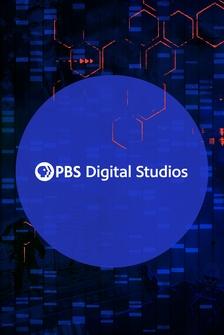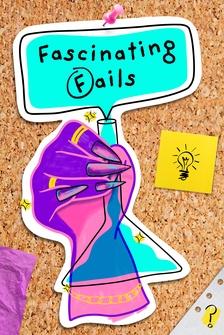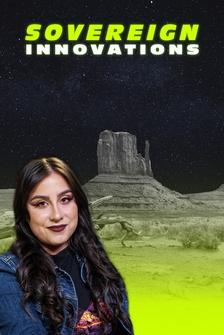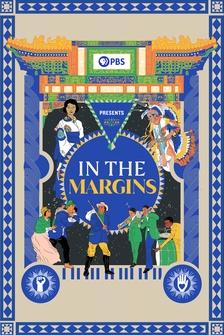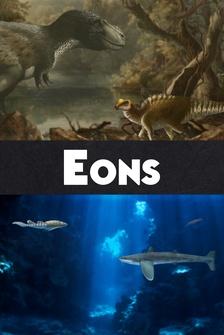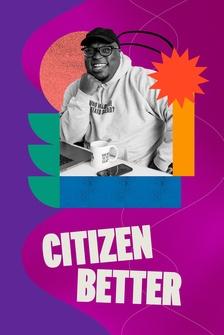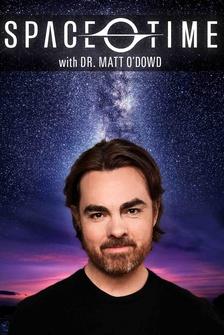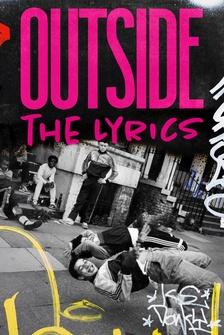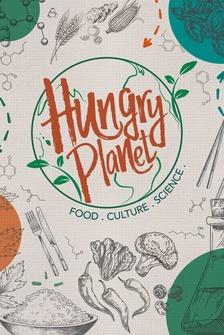- [Caitlin] Water, the molecule that makes life on earth possible, but the water that we put in our bodies isn't just water.
- Unfortunately, many primary contaminants don't have a smell or a taste.
- [Caitlin] And what is in it profoundly affects our health.
So what is it about water that makes it so special?
- Come on, push through!
We came here for one reason, we're gonna break a sweat.
- [Caitlin] We plan to put in the hard work to find out.
- You're doing great, Arlo.
(laughs) - I'm Caitlin Saks.
- And I'm Arlo Perez.
You might know us from our most recent series, "Antarctic Extremes".
- We were pretty excited to see that series come out, but just after it did.
- This disease.
- Coronavirus.
- The surge of cases.
- The world seemed to fall apart.
- And we went from being on the most exciting adventure of our lives to being stuck in our apartments for pretty much a year.
- Hey Arlo, how's it going?
- It's all right.
Been a long pandemic though, so.
- I've got some news that's gonna cheer you up.
We have got a new show to make for Nova and PBS.
- (laughs) Oh, okay, okay.
So where are we going?
- Well, that's the best part, we don't have to go anywhere.
It's on chemistry.
- [Echo] Chemistry, chemistry.
(dramatic music) - I was thinking our first episode would be on water.
- What?
- Now, before you hit unsubscribe, bear with me for a second.
Water might sound boring, but once you get to know water up close and personal, like on a molecular level, it is one of the most fascinating molecules in the universe.
Water is liquid at room temperature, unlike just about every other molecule of comparable size.
Its solid form, ice, is less dense than its liquid form, making it float.
Water clumps together, forming tight little spherical droplets when it rains.
And it is one of the most important molecules for us humans.
Our bodies are made up of about 60% water.
- And that really peaked my interest.
Think about it, if we're about 60% water, then that means that we're basically walking sacks of water.
But why water?
Why not something else?
- To understand water in our bodies, we figured it would be easiest to focus on the water that comes out of our bodies.
- After considering several candidates, we settled on sweat.
- Sweat is about 99% water, but it's actually the other 1% that gives us some clues as to why it's water that makes up our bodies.
- So what else is in our sweat?
To find out, we need a Sweat Scientist.
Yes, they exist.
- So, you study sweat?
- Yes.
- That's gross.
- (laughs) It is gross.
It's especially gross when someone's sweat gets on you.
But you know, it's all for the sake of research.
- Shy works for GSSI, the Gatorade Sports Science Institute.
Yeah, like the sports drink.
- [Arlo] And no, this doesn't mean she's trying to figure out how to get people to sweat neon.
- [Caitlin] Shy and the GSSI team aim to understand precisely what athletes are losing in their sweat.
- GSSI has worked with thousands of athletes in order to perform sweat testing.
- [Caitlin] Sweating is how our body cools itself.
But when we sweat, we lose more than just water, which makes sweaty athletes the best test group to understand what is in sweat.
- We provide nutritional recommendations on how much an athlete should be replenishing before, during and after a game or practice.
- [Caitlin] This makes Shy the perfect person to help us understand what is in this fluid that is so important to us.
But first, we need some water 101.
- [Shy] Water is a simple molecule, it's actually going to contain two hydrogen atoms and one oxygen atom.
- [Caitlin] Simple, but there's a catch.
The hydrogens and oxygen share some electrons, but the oxygen atoms hog the electrons just a bit more making that side of the molecule have a slightly more negative charge.
While the two hydrogen atoms each have a slightly more positive charge.
This makes it what is called a polar molecule.
- Scientists call something polar when it has two clear opposite ends.
So magnets are polar, batteries are polar and water molecules are polar.
- So what does water's polarity have to do with us?
To find out, Shy is gonna analyze our sweat.
And for that, we've gotta sweat it out.
This is a fairly intense kit.
- What I will do is pack a nice little kit for you guys with all the necessary materials.
You'll open it up, you'll see some patches, tubes, gloves.
Pre-bodyweight and post-bodyweight are gonna be very important as well as anything that you may eat.
- This is cottage cheese, much higher protein.
- Are you getting that?
(Caitlin laughs) - So we've gotta weigh how much we pee.
- Yes, if you do pee, but if you don't pee, it's fine.
- You do realize I'm pregnant, I pee every 15 minutes.
- Well, we need that pee, so put that pee in that nice bag that we sent you.
- [Caitlin] These patches are actually going to collect the sweat that Shy will later analyze to see what's in it.
- [Arlo] Now all there's left to do is, well, sweat.
(bright music) - Let's go, let's go.
Everybody on your mat, start jogging in place.
Jogging in place.
Go, bring it back.
To the center, now to the side.
Don't give up here, come on push through.
We came here for one reason, we're gonna break a sweat.
Everybody come down to your hands and knees.
We're gonna take a couple of cat cows here.
Arlo, take a lap, let's go.
Really nice, Caitlin, looking great.
Faster.
(bright music continues) - You better leave some yogurt for me, Caitlin.
- It's a little too late.
I got some peanut butter though.
- [Arlo] Did you bring an extra spoon?
- No, we gotta share a spoon.
- [Lily] Four, three, two, one.
- If it's taking you this long to fill up a sweat pad, I'm in trouble.
Should I put the sweatsuit on?
- I think you should put the sweatsuit on.
- It's pretty dreadful.
- Do you look like Rocky?
- Like a pregnant Rocky.
- [Arlo] Pretty sure exercise is good for the baby.
- [Caitlin] I'm pretty sure you've never been pregnant, Arlo.
- [Arlo] When Shy receives our samples, she puts them in a centrifuge to extract our sweat.
And then she measures our hard day's work.
- Caitlin, since you didn't have any sweat, we pretty much just get rid of you, we don't need this at all, done.
- [Arlo] I can't believe Caitlin didn't sweat.
I saw how much she tried.
- [Caitlin] I might not be a pro level sweater, but Arlo provided enough sweat for Shy to analyze using this, a high performance liquid chromatography instrument.
- The machine does pretty much all the work for me.
It will form this chromatogram, which you're able to see different peaks of the different ions.
For Arlo's first sample, we have a total of 1,708 milligrams per liter of sodium in his sweat.
Of course, other things were picked up in Arlo's sweat, such as potassium and chloride.
- [Arlo] Sodium, potassium, chloride, these are all electrically charged ions that are formed when electrolytes like salt, dissolve in water.
- Electrolytes pretty much help with the body's processes and functions.
We want to make sure that we're helping that athlete optimize their performance.
Whatever they lose, sweat, electrolytes, we wanna make sure that that is going to be replenished in a beverage that is containing water, electrolytes and also carbohydrates as well.
- And of course, this doesn't apply just to athletes.
Electrolytes play a role in many of our essential bodily functions, including transmission of neuro signals, blood clotting, and even our heartbeat.
This is part of why water is so important.
It carries this crucial stuff around our bodies.
- So how does water do this?
It all gets back to that polar nature of the water molecule, which actually helps to pull apart compounds like salt, NaCl.
The negative side of the water attracts positive ions like sodium, Na, while the positive side of the water molecule attracts the negative ions like chloride, Cl.
In other words, water dissolves stuff.
So we can see from our sweat that it is the chemical structure of water that makes it the perfect conduit for the stuff our body needs.
And it isn't just electrolytes.
The water in our bodies carries all sorts of important things, amino acids, vitamins, sugar, iron, the list goes on and on.
In fact, water's special properties make it crucial for every living thing on earth, but water's amazing ability to dissolve and carry things also comes with a downside.
- Just because it flows in our tap water and it's clear and smell-free, it's not guaranteed to be safe.
- [Arlo] This is Susana De Anda.
She's a Water Advocate working in California Central Valley, and she pointed out something that is pretty surprising.
- I like to say that looks can be very deceiving.
Here, we have two water samples.
This water bottle here, it smells bad, it tastes horrible, but it's not gonna get you sick.
This water bottle has nitrates.
This one is a serious and primary contaminant than no one needs to be drinking.
- [Caitlin] Similar to how water can dissolve or carry stuff our body really needs, like electrolytes, it can also carry pollutants that are detrimental to us.
- In California, the reality is we have over 1 million Californians without safe drinking water.
And the vast majority of these systems are plagued with multiple contaminants ranging from nitrates, arsenic, DBCP, 1,2,3-TCP, chromium six.
- It gets worse.
Not only can water pick up harmful contaminants, but most of the water in the planet is actually too salty for bodies to process properly.
- Even though our bodies need some salts, the planet's oceans have too much dissolved salt for us to drink safely.
If we did, then the relatively fresh water in our cells would literally move out of cells to balance out the saltiness of the water we just ingested.
In other words, it would dehydrate us, which is a problem because although 70% of our planet is water, only 3% of that is fresh water.
As we use up the fresh water we do have, we are facing a global water crisis.
A 2018 UN report states that by 2050, over 5 billion people could be facing water scarcity.
And this is a problem clearly already being felt by some communities.
- There is no greater crisis facing our state today than its lack of water.
- Droughts have become part of our life in California.
We're currently going into another drought.
Many families have not recovered from the last drought.
- [Narrator] They haven't had clean drinking water for 10 years.
- [Reporter] Living without running water is now the new normal.
- [Reporter] Living in poverty.
She gave the leftover dish water to her kids.
- [Narrator] At the end of the day, everyone's just trying to make do with the drought.
Some are just making out a whole lot better.
- Clean water flows towards money and power.
It's not a coincidence, if you look like me and you live in the Central Valley, you're going to have higher chances of having un-potable drinking water.
- Water is a fascinating and powerful molecule.
It's the chemistry of water that makes it the molecule that allows for life to thrive on earth.
Its chemistry makes it the molecule that carries things that are vital for our bodies, but at the same time, it can carry things that are harmful or even deadly to us.
So this molecule that makes us could also be the molecule that breaks us.
- 1 in 10 people in the world don't have access to safe drinking water.
Access to safe water, access to affordable drinking water has to be a human right across our planet.
And we need to recognize that as humans, we need to protect this liquid.
I believe clean water is a basic human right.
And that should never be a privilege.
- All right, right.
This episode aside, you have more news, right?
Look at that, look at that.
Wait, are you still calling it a potato Saks?
- I've moved on to calling him Proto.
- Like Promethease or.
- Like Proteus.
- Oh, even nerdier.
(all laugh)




